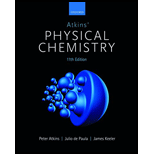
Concept explainers
(i)
Interpretation: The overall mole fraction of aniline in the given mixture under given conditions has to be calculated.
Concept introduction: The mole fraction is used as the unit to express the concentration. It is calculated by taking the ratio of number of mole of a particular component to the total number of moles of the mixture. It is given by the formula as,
xa=nantotal
(ii)
Interpretation: The relative amount of two phases has to be stated using the lever rule.
Concept introduction: The lever rule is used to determine the relative amount of the components in the phases which are represented in the phase diagram. According to the lever rule, the ratio of composition of each phase of a component is equal to the ratio of distances in the phase diagram. It is represented by the formula as,
nαnβ=lβlα
Want to see the full answer?
Check out a sample textbook solution
Chapter 5 Solutions
Atkins' Physical Chemistry
- Please complete these blanks need that asaparrow_forwardNitration of Methyl Benzoate: 1. Predict the major product for the reaction below AND provide a mechanism. Include ALL resonance structures for the intermediate. C(CH3)3 NO₂* ? 2. Assuming the stoichiometry is 1:1 for the reaction above, what volume of concentrated nitric acid would be required to mononitrate 0.50 grams of the compound above? What product(s) might you expect if you nitrated phenol instead of methyl benzoate? Explain your reasoning. What signals appeared/disappeared/shifted that indicate that you have your intended product and not starting material? What other impurities are present in your product and how do you know?arrow_forwardSodium Borohydride Reduction (continued on the next page): 1. Draw the product of each of the reactions below and give the formula mass to the nearest whole number. ? (1) NaBH (2) acid (1) NaBD4 (2) acid ? 2. In mass spectra, alcohols typically break as shown in equation 8 in chapter 11 (refer to your lab manual). The larger group is generally lost and this gives rise to the base peak in the mass spectrum. For the products of each of the reactions in question # 1, draw the ion corresponding to the base peak for that product and give its mass to charge ratio (m/z). 3. Given the reaction below, calculate how many mg of 1-phenyl-1-butanol that can be produced using 31 mg NaBH4 and an excess of butyrophenone. 4. + NaBH4 OH (after workup with dilute HCI) What signals appeared/disappeared/shifted that indicate that you have your intended product and not starting material? What other impurities are present in your product and how do you know?arrow_forward
- Aspirin from Wintergreen: 1. In isolating the salicylic acid, why is it important to press out as much of the water as possible? Write a step-by-step mechanism for the esterification of salicylic acid with acetic anhydride catalyzed by concentrated H₂SO4. 3. Calculate the exact monoisotopic mass of aspirin showing your work. What signals appeared/disappeared/shifted that indicate that you have your intended product and not starting material? What other impurities are present in your product and how do you know?arrow_forwardSynthesis of Ibuprofen-Part 1: 1. What characteristic absorption band changes would you expect in the IR spectrum on going from p-isobutylacetophenone to 1-(4-isobutylphenyl)-ethanol and then to 1-(4-isobutylphenyl)-1-choroethane as you did in the experiment today? Give approximate wavenumbers associated with each functional group change. Given that the mechanism of the chlorination reaction today involves formation of a benzylic carbocation, explain why the following rearranged product is not formed. محرم محمد 3. Why do we use dilute HCl for the first step of the reaction today and concentrated HCI for the second step? What signals appeared/disappeared/shifted that indicate that you have your intended product and not starting material? What other impurities are present in your product and how do you know?arrow_forwardAssign only the C NMRarrow_forward
- 2. Identify the reagents you would need to achieve the following. You may need to consider using a protecting group. HO 1. 2. 3. 4. 5. OH Br HOarrow_forwardBeF2 exists as a linear molecule. Which kind of hybrid orbitals does Be use in this compound? Use Orbital Diagrams to show how the orbitals are formed. (6)arrow_forwardPlease answer the questions and provide detailed explanations as well as a drawing to show the signals in the molecule.arrow_forward
 ChemistryChemistryISBN:9781305957404Author:Steven S. Zumdahl, Susan A. Zumdahl, Donald J. DeCostePublisher:Cengage Learning
ChemistryChemistryISBN:9781305957404Author:Steven S. Zumdahl, Susan A. Zumdahl, Donald J. DeCostePublisher:Cengage Learning ChemistryChemistryISBN:9781259911156Author:Raymond Chang Dr., Jason Overby ProfessorPublisher:McGraw-Hill Education
ChemistryChemistryISBN:9781259911156Author:Raymond Chang Dr., Jason Overby ProfessorPublisher:McGraw-Hill Education Principles of Instrumental AnalysisChemistryISBN:9781305577213Author:Douglas A. Skoog, F. James Holler, Stanley R. CrouchPublisher:Cengage Learning
Principles of Instrumental AnalysisChemistryISBN:9781305577213Author:Douglas A. Skoog, F. James Holler, Stanley R. CrouchPublisher:Cengage Learning Organic ChemistryChemistryISBN:9780078021558Author:Janice Gorzynski Smith Dr.Publisher:McGraw-Hill Education
Organic ChemistryChemistryISBN:9780078021558Author:Janice Gorzynski Smith Dr.Publisher:McGraw-Hill Education Chemistry: Principles and ReactionsChemistryISBN:9781305079373Author:William L. Masterton, Cecile N. HurleyPublisher:Cengage Learning
Chemistry: Principles and ReactionsChemistryISBN:9781305079373Author:William L. Masterton, Cecile N. HurleyPublisher:Cengage Learning Elementary Principles of Chemical Processes, Bind...ChemistryISBN:9781118431221Author:Richard M. Felder, Ronald W. Rousseau, Lisa G. BullardPublisher:WILEY
Elementary Principles of Chemical Processes, Bind...ChemistryISBN:9781118431221Author:Richard M. Felder, Ronald W. Rousseau, Lisa G. BullardPublisher:WILEY





